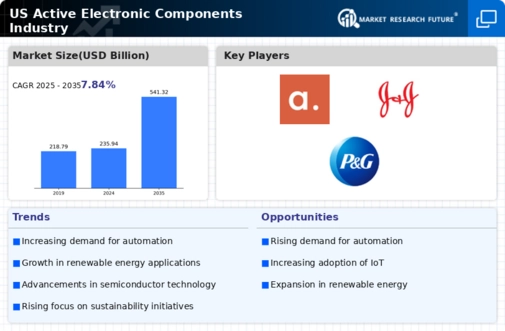Advancements in IoT Applications
The proliferation of Internet of Things (IoT) applications is a key driver for the active electronic-components market. As industries increasingly adopt IoT technologies for automation and data collection, the demand for components such as microcontrollers, sensors, and connectivity modules is expected to rise. In 2025, the IoT market is projected to reach $1 trillion, indicating a substantial opportunity for the active electronic-components market. This growth is likely to be fueled by the need for smart devices in sectors such as healthcare, manufacturing, and agriculture. The active electronic-components market must focus on developing components that are not only efficient but also capable of supporting the vast network of interconnected devices. As a result, collaboration between component manufacturers and IoT solution providers may become increasingly important to drive innovation and meet market demands.
Rising Consumer Electronics Demand
The active electronic-components market experiences a notable surge in demand driven by the increasing consumption of consumer electronics. As households adopt smart devices, the need for components such as semiconductors and integrated circuits escalates. In 2025, the consumer electronics sector is projected to grow by approximately 5.5%, which directly influences the active electronic-components market. This growth is attributed to the proliferation of smartphones, tablets, and smart home devices, all of which require advanced electronic components for functionality. The active electronic-components market must adapt to this rising demand by ensuring a steady supply of high-quality components to meet consumer expectations. Furthermore, manufacturers are likely to invest in research and development to innovate and enhance product offerings, thereby fostering a competitive landscape within the market.
Expansion of Automotive Electronics
The automotive sector's transformation towards electrification and automation significantly impacts the active electronic-components market. With the increasing integration of electronic systems in vehicles, the demand for components such as sensors, microcontrollers, and power management ICs is on the rise. In 2025, the automotive electronics market is expected to reach $300 billion, indicating a robust growth trajectory. This expansion is driven by the need for advanced driver-assistance systems (ADAS) and electric vehicles (EVs), which rely heavily on sophisticated electronic components. The active electronic-components market must respond to this trend by enhancing production capabilities and focusing on innovation to cater to the evolving requirements of the automotive sector. As a result, partnerships between automotive manufacturers and electronic component suppliers are likely to strengthen, fostering a collaborative environment.
Growth in Telecommunications Infrastructure
The active electronic-components market is poised for growth due to the ongoing expansion of telecommunications infrastructure across the United States. The rollout of 5G technology necessitates a significant upgrade in network components, including amplifiers, filters, and transceivers. By 2025, investments in telecommunications infrastructure are projected to exceed $100 billion, reflecting a strong commitment to enhancing connectivity. This growth is likely to drive demand for high-performance electronic components that can support the increased data transmission rates and lower latency associated with 5G networks. The active electronic-components market must align its production strategies to meet the specific needs of telecommunications providers, ensuring that components are not only reliable but also capable of supporting future advancements in communication technology.
Increased Focus on Renewable Energy Solutions
The active electronic-components market is influenced by the growing emphasis on renewable energy solutions, particularly in the context of solar and wind energy systems. As the United States aims to transition towards sustainable energy sources, the demand for electronic components that facilitate energy conversion and management is expected to rise. In 2025, the renewable energy market is anticipated to grow by approximately 8%, which will likely drive the active electronic-components market to innovate and produce components that enhance energy efficiency. This shift towards sustainability may also encourage manufacturers to adopt eco-friendly practices in their production processes, thereby aligning with broader environmental goals. Consequently, the active electronic-components market could see an influx of investment aimed at developing advanced technologies that support renewable energy initiatives.















Leave a Comment